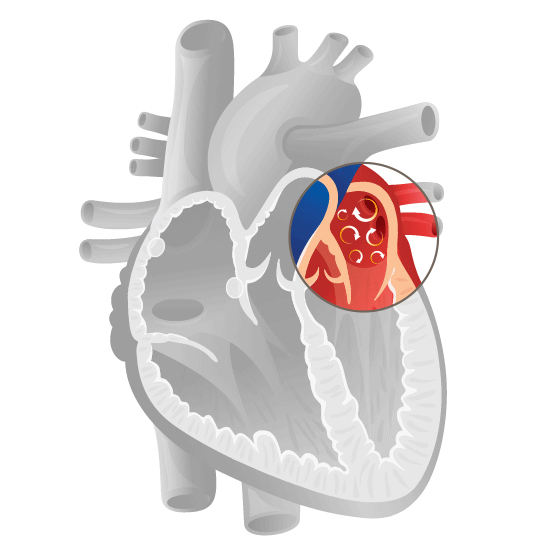Atrial fibrillation is a type of cardiac arrhythmia in which the atria no longer beat in time with the ventricles. Atrial fibrillation is not immediately life-threatening, but increases the risk of secondary diseases such as stroke and should therefore be diagnosed and treated in any case.
Overview
Atrial fibrillation is the most common form of cardiac arrhythmia, where the heartbeat becomes out of sync and the atria beat faster than the ventricles. This is due to the electrical impulse for cardiac activity, which usually emanates from the sinus node in the right atrium. The pulse is transmitted from the atria to the ventricles in a time-coordinated manner. Atrial fibrillation refers to a disruption to this coordinated process. Electrical pulses also emanate from other parts of the atria, leading to atrial fibrillation or atrial flutter.
As a result of atrial fibrillation, the ventricles and atria no longer pump in time, reducing the heart’s pumping capacity and blood flow to the body. This can lead to various symptoms such as heart palpitations, tightness in the chest, dizziness and tiredness.
Age
Atrial fibrillation mainly occurs in people over the age of 65, as the heart wears out over time and the electrical regulation of the heart becomes more susceptible to disorders.
High blood pressure (hypertension)
High blood pressure damages the heart and blood vessels, which can lead to atrial fibrillation.
Other risk factors
There are also other risk factors that may favour atrial fibrillation:
- existing heart conditions
- diabetes
- hypothyroidism
- sleep apnoea
- smoking
- certain medications
- overweight and obesity (adiposis)
- critical alcohol consumption
Paroxysmal atrial fibrillation
Paroxysmal atrial fibrillation is referred to when the attacks tend to disappear independently within 48 hours.
Persistent atrial fibrillation
Persistent atrial fibrillation lasts for more than seven days and does not go away on its own. However, it is possible to re-regulate the heartbeat with treatment.
Long-standing persistent atrial fibrillation
Atrial fibrillation that lasts longer than 12 months is known as long-standing persistent atrial fibrillation.
Permanent atrial fibrillation
In the case of permanent atrial fibrillation, medication is no longer sufficient for restoring a normal sinus rhythm and the condition remains permanently.
Although the occurrence of atrial fibrillation is not immediately life-threatening, if left untreated, it can lead to serious complications:
Increased risk of stroke
The irregular pumping activity of the heart can result in the formation of blood clots, which can enter the brain vessels and trigger a stroke.
Increased risk of heart failure
The reduced pumping capacity of the heart can lead to heart failure in the long term. The heart is no longer able to supply the body with sufficient blood and oxygen.

For this reason, atrial fibrillation should always be diagnosed and treated by a cardiologist.
Symptoms
The symptoms of atrial fibrillation can be vary greatly. Some people have no symptoms, while others experience the following:
- Rapid pulse (heart palpitations)
- Irregular heartbeat
- Tightness and pressure in the chest
- Tiredness and weakness
- Shortness of breath
- Dizziness
- Drowsiness
Diagnosis
Atrial fibrillation is usually diagnosed by a specialist (cardiologist); this process can be divided into the following steps:
Case history
During a consultation, the patient’s medical history is recorded based on specific questions.
Physical examination
In the next step, the doctor measures blood pressure, checks pulse and listens to the heart.
Electrocardiogram (ECG)

The electrical activity of the heart is then recorded using an electrocardiogram, as atrial fibrillation can be detected by an irregular ECG pattern.
Long-term ECG
If atrial fibrillation only occurs occasionally, a long-term ECG is used. The long-term ECG records cardiac activity over a period of 24 hours or more.
Echocardiography
An echocardiography, which is an ultrasound examination of the heart, can be used to investigate the cause of atrial fibrillation.
Treatment
Treatment of atrial fibrillation is aimed at relieving symptoms, reducing the risk of complications and controlling heart rate. Due to the different origins, forms and risk factors of atrial fibrillation, the treatment is individually adapted to the patient.
If the origin of the atrial fibrillation is known, the existing underlying disease should first be treated consistently. In case of unknown origin or ineffective treatment of the underlying disease, medications for controlling heart rate or rhythm and blood thinning may be used. However, electrophysiological measures, such as electrical cardioversion or catheter ablation (heart ablation), often achieve a lasting result. Certain forms of atrial fibrillation also allow for the disease to be treated using a surgical intervention.
Prevention
The risk of atrial fibrillation can be reduced by pursuing a healthy lifestyle with
- regular exercise,
- a balanced diet,
- adequate sleep,
- low stress,
- moderate alcohol consumption and
- no smoking.
In addition, regular medical check-ups and taking medication for certain known risk factors may be proposed as preventive measures.
Centres 10
-
24-hour emergency centre
Schänzlihalde 11
3013 Bern -
Outpatient Clinic Permanence
Bümplizstrasse 83
3018 Bern

